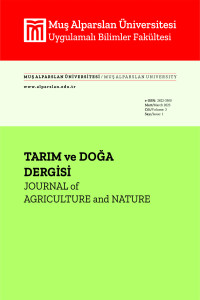Derleme
Araştırma Makalesi
Amaç ve Kapsam
Muş Alparslan Üniversitesi Tarım ve Doğa Dergisi öncelikli olarak bölgesel veya küresel bağlamda Tarımsal Üretim ve Teknolojileri temel disiplinine dayanan; Bahçe Bitkileri, Bitki Koruma, Biyosistem Mühendisliği, Çevre Bilimleri, Gıda Bilimi ve Teknolojisi, Tarım Ekonomisi, Tarla Bitkileri, Tarımsal Biyoteknoloji, Toprak Bilimi, Bitki Besleme, Zootekni, Su bilimi, denizcilik, su ürünleri yetiştiriciliği, balıkçılık yönetimi çevre bilimleri gibi bilim alanlarında yapılmış yüksek kaliteli, özgün ve yenilikçi bilgilerin irdelendiği araştırma makalelerinin yanı sıra sınırlı sayıda davet edilmiş derleme makalesi, kısa araştırma notu/teknik not, vaka takdimi gibi yayın kategorilerinden de başvuruları kabul eden ve yayınlanmasını sağlayan açık erişimli bir araştırma dergisidir. Muş Alparslan Üniversitesi Tarım ve Doğa Dergisi yayımlanan makaleler için herhangi bir ücret talep etmez.
Araştırma alanları şunları içerir (ancak bunlarla sınırlı değildir):
- Uygulamalı Bilimler
- Biyomühendislik
- Çevre Mühendisliği
- Gıda Mühendisliği
- Nano Teknoloji Mühendislik
- Su Ürünleri Bilimleri ve Mühendisliği
- Ziraat Mühendisliği
- Biyoloji
- Coğrafi Bilgi Teknolojileri
- Doğal Afet Yönetimi
- Enerji Kaynakları ve Yönetimi
- Fizik
- İstatistik ve modelleme
- İş Sağlığı ve Güvenliği
- Kimya
- Deniz Teknolojileri
- Deniz Biyolojisi
- Balıkçılık
- Su Ürünleri Yetiştiriciliği
- Denizcilik
- Biyoteknoloji
- Ekoloji
- Kirlilik
- Balıkçılık yönetimi
- Telemetri ve uzaktan algılama
- Balık Teşhisi ve Hastalığı
- Balık Beslenmesi
- Gıda işleme
- Hidroloji
- Limnoloji
- Oşinografi
- Sürdürülebilir ekosistem
- Küresel ısınma
- Su havzası yönetimi
Muş Alparslan Üniversitesi Tarım ve Doğa Dergisi yayıncılık hayatına Ocak 2021 yılında Muş Alparslan Üniversitesi Tarımsal Üretim ve Teknolojileri Dergisi (E-ISSN: 2757-8763) ismiyle başlamış 2022 Mart’ta isim değişikliği olmuştur. Muş Alparslan Üniversitesi Tarım ve Doğa Dergisi uluslararası hakemli Türkçe ve İngilizce bir dergidir. Bahçe Bitkileri, Bitki Koruma, Biyosistem Mühendisliği, Çevre Bilimleri, Gıda Bilimi ve Teknolojisi, Tarım Ekonomisi, Tarla Bitkileri, Tarımsal Biyoteknoloji, Toprak Bilimi, Bitki Besleme, Zootekni, Biyoloji, Su Ürünleri, Denizcilik ve Uygulamalı Bilimler alanlarında orijinal makaleler, derlemeler, kısa yazılar ve editöre mektuplar hakem değerlendirilmesinden sonra yayınlanmak üzere kabul edilmektedir. Derginin yazım kurallarına uygun olarak hazırlanan makaleler dergi editörü tarafından değerlendirilmek üzere hakemlere gönderilmektedir. Kör hakem uygulaması gözetilmekte ve her makale iki farklı hakem tarafından değerlendirilmektedir. Dergi editörü ve editor kurulu, hakem değerlendirilmelerine göre makalenin dergide yayınlanmak üzere kabul edilip edilmeyeceğine karar verir.
Daha önce başka bir yerde yayımlanmış makaleler değerlendirme kapsamına alınmamaktadır. Dergide yayınlanan makalelerin tüm sorumlulukları (bilimsel, mesleki, etik, yasal vb.) makale yazarlarına aittir. Yayınlanan makalelerin telif hakları derginin mülküyeti ve referansı olmadan devredilemez
Yazım Kuralları
Başvuru Dosyaları
1. Makale Şablonu- İndirmek için Tıklayınız
2. Telif Hakkı Devir Formu- İndirmek için Tıklayınız
3. Etik Kurul İzni Bilgi Beyanı- İndirmek için Tıklayınız
4. Benzerlik Raporu- Turnitin, iThenticate, intihal.net programlarını kullanabilirsiniz.
Makale Türleri
Orjinal araştırma makaleleri, derleme makaleleri, kısa makale, editöre mektup kabul edilmektedir. Orjinal araştırma makaleleri daha önce başka bir yerde yayımlanmamış olmalı ve 7500 kelime ya da 25 sayfayı (tablolar ve görseller dahil) geçmemelidir. Derleme makaleleri, belli bir alanda 10.000 kelime ya da 30 sayfayı (tablolar ve görseller dahil) geçmemelidir. Kısa makaleler çalışmanın ön aşamasını ve doğasını açıklayacak şekilde olmalı ve 3000 kelime ya da 10 sayfayı (tablolar ve görseller dahil) geçmemelidir. Editöre Mektup, güncel konuları kapsamaları ve 2000 kelime ya da 8 sayfayı (tablolar ve görseller dahil) geçmemelidir.
Makale Hazırlığı
Makaleler Türkçe ya da İngilizce dilinde yazılmalı ve bir kelime işlemci programı kullanılarak “.doc” ya da “.docx” formatlarında kaydedilmelidir. Makale boyunca 12 puntolu Times New Roman fontu (referanslar, tablo ve şekil başlıkları dahil) kullanılmalı, çift aralıklı ve A4 boyutunda her tarafında 25 mm kenar boşluklu sayfa düzeni tercih edilmelidir. Metin tek sütünda mümkün olduğunca basit olmalı ve sözcükler tire kullanılarak ayrılmamalıdır. Cins ve tür isimleri italic olarak verilmeli ve metinde ilk bahsedildiği yerde “should be followed by the authority”. Makaleler aşağıdaki sıraya göre yapılandırılmalıdır:
Başlık Sayfası
o Başlık
o Yazar isimleri, ORCID ID, tam adresleri
o Sorumlu yazarın mail adresi
Ana Metin
o Başlık yazar isimleri dahil edilmeden eklenmelidir (Türkçe makaleler için hem Türkçe hem İngilizce gerekmektedir)
o Özet (Türkçe makaleler için hem Türkçe hem İngilizce gerekmektedir
o Anahtar Kelimeler
o Giriş
o Materyal ve Yöntem
o Sonuçlar ve Tartışma ( Bu kısmı yazar isterse iki ayrı başlık olacak şekilde yazar ele alabilir)
o Sonuçlar
o Teşekkür (gerekli ise)
o Kaynakça
Tablo ve Figurler metin üzerinde uygun olan yerlerde başlıkları ile beraber verilmelidir.
Appendiks (gerekli ise)
Teşekkür
Minimum uzunlukta tutulmalı ve kaynakçadan önce yerleştirilmelidir.
Kaynakça
Metin içinde kaynak gösterme
Lütfen kaynakçada verilen bir referansların aynı zamanda metin içinde de kaynak gösterildiğinden emin olunuz. Literatürü kaynak gösterirken örnekteki gibi önce alfabetik sıraya sonra yıla göre kaynak gösteriniz (Şimşek, 2018; Şimşek and Demirci, 2018; Şimşek et al., 2018). Türkçe makaleler için (Şimşek, 2018; Şimşek ve Demirci, 2018; Şimşek ve ark., 2018). Eğer kaynakça cümle içinde kullanılacaksa sadece tarihi parantez içinde gösteriniz. Örneğin: Kale (2012); Can and Yılmaz (2014); Kılıç et al. (2019)
· Tek isim: yazar ismi ve yayınlanma
· İki yazarlı: iki yazarın da adı ve yayımlanma yılı
· Üç ya da daha fazla yazarlı: İlk yazarın adının arkasından “et al.” ibaresi yerleştirilir ve yayımlanma yılı verilir
Kaynakçada kaynak gösterme; Kaynaklar önce alfabetik olarak ardından da kronolojik olarak sıralanmalıdır. Aynı yazar (lar) dan aynı yılda birden fazla kaynak olduğu taktide yayın tarihinden sonra a,b,c, vb. harflerle belirtilmelidir.
Dergi makaleleri, kitaplar, birden fazla bölümden oluşan kitaplar ve online basılan makaleler aşağıdaki örnekler doğrultusunda kaynak gösterilmelidir.
Makale:
Demirci, A. (2007). The evaluation of a red shrimp Plesionika martia (Decapoda: Pandalidae) in North-East Mediterranean trawl fishery. Ege Journal of Fisheries and Aquatic Sciences, 24(1), 93-96.
Şimşek, E., & Demirci, A. (2018). Barotrauma treatment effects on survival rates for some discarded fish by trawl fishery. Fresenius Environmental Bulletin, 27(7), 4867-4873.
Demirci, S., Özyılmaz, A., Öksüz, A., Nadir, R. S. & Şimşek, E. (2018). Otolith chemistry of Champsodon nudivittis (Ogilby, 1895) and Nemipterus randalli (Russell, 1986) in Iskenderun Bay, Turkey. Journal of Applied Ichthyology, 34(5), 1131-1135. https://doi.org/10.1111/jai.13761
Kitap:
Brown, C., Laland, K. & Krause, J. (Eds.) (2011). Fish cognition and behavior. 2nd ed. Oxford, UK: Wiley-Blackwell. 472 p.
Kitap Bölümü:
Langston, W. J. (1990). Toxic effects of metals and the incidence of marine ecosystems. In: Furness, R.W. (eds.), Rainbow heavy metals in the marine environment. CRC Pres., New York. p. 102-122.
Vassallo, A.I. & Mora, M.S. (2007). Interspecific scaling and ontogenetic growth patterns of the skull in living and fossil ctenomyid and octodontid rodents (Caviomorpha: Octodontoidea). In: Kelt, D.A., Lessa, E., Salazar-Bravo, J.A., Patton, J.L. (eds.), The Quintessential Naturalist: Honoring the Life and Legacy of Oliver P. Pearson. 1st ed. Berkeley, CA, USA: University of California Press, 945-968.
Tez:
Şimşek, E. (2018). Trol balıkçılığında ıskartanın yaşama ihtimalini etkileyen faktörlerin analizi. Doktora tezi, İskenderun Teknik Üniversitesi, Hatay, Türkiye, 101 s.
Şimşek, E. (2018). Analysis of the factors affecting the discard fate for trawl fishery. Ph. D. Thesis, Iskenderun Technical University, Hatay, Turkey, 101 pp. (In Turkish).
Konferans Bildirileri:
Demirci, A., Şimşek E., Demirci, S., Akar, Ö. & Bayraktar, O. (2018). Recreational fishing competitions in Turkey. International Ecology 2018 Symposium, Kastamonu, Turkey Proceedings Book, 505-506.
Enstitü Baskıları:
FAO, (2016). The State of World Fisheries and Aquaculture: Contributing to food security and nutrition for all. Rome. 200 pp.
Raporlar:
FAO, (2018). Report of the ninth session of the Sub-Committee on Aquaculture. FAO Fisheries and Aquaculture Report No. 1188. Rome, Italy.
İnternet Kaynakları:
Froese, R. & Pauly, D. (Eds.) (2018). FishBase. World Wide Web electronic publication. Retrieved on January 11, 2018 from http://www.fishbase.org.
Tablolar
Tablolar Arap rakamlarına göre sıralanmalı ve metin içinde en uygun olan yerlere başlıkları ile beraber yerleştirilmelidir. Dipnotları tablo gövdesinin altındaki tablolara yerleştirin ve bunları küçük harflerle (veya anlamlılık değerleri ve diğer istatistiksel veriler için yıldız işaretleriyle) belirtilmelidir. Diket sütün kullanımında kaçınılmalıdır. Tablolarda gösterilen verilen metin içinde tekrarlara yer verecek şekilde gösterilmemelidir.
Şekiller
Metinde tüm resimler 'Şekil' olarak etiketlenmeli ve birbirini izleyen Arapça rakamlarla, Şekil 1, Şekil 2 vb. şeklinde numaralandırılmalıdır. Bir şeklin içindeki panellee etiketlenmişse (a, b, vb.), metinde bu panellere atıfta bulunurken hem şekil hem panel kodunu bir arada kullanın. Yüksek kaliteli lazer yazıcı ile çoğaltılabilecek kalitedeki çizimler tercih edilmektedir. Kullanılan fotoğraflar iyi kontrastlı olmalı ve parlak kağıt üzerine basılabilir olmalıdır. PNG, JPEG gibi elektronik formatlar için önerilen şekiller. TIFF (min. 300 dpi) de mevcut boyutlarda düzenlenmelidir. Tüm şekiller veya tablolar metin içinde sunulmalıdır. Tüm şekiller ve tablolar için Times New Roman yazı tipini kullanın. Yazı tipi boyutları 9 ila 12 punto arasında olmalıdır.
Etik İlkeler ve Yayın Politikası
EDİTÖRLERİN VE YAYIN KURULUNUN SORUMLULUKLARI
Yayın Sorumlulukları ve Bağımsızlık
Gizlilik ve Çıkar Çatışması
Dergi editörleri ve Editörler Kurulu üyelerinin gönderilen materyalleri bölüm editörleri, istatistik editörleri, dil editörleri, tasarım editörleri ve diğer editöelr dışındaki 3. Kişilerle paylaşması ve/ veya kendileri kullanmaları yazaktır.Bir editör ile bir yazar veya yazarın çalıştığı kurum arasında işbirliği veya rekabet açısından bir çıkar çatışması varsa değerlendirme sürecini yönetmek üzere Yayın Kurulu'ndan başka bir üye görevlendirilir.
Editörler, alanında uzman en az iki hakem tayin ederek gönderilen makalelerin hakem incelemesini sağlar. Yazıların araştırmacılar ve okuyucular için önemi, hakem raporları, intihal ve telif hakkı ihlali hukuki konular olarak dikkate alınarak bir makalenin yayınlanması kararından baş editör sorumludur. Baş editör, kararını diğer editörler ve hakemlerle tartışabilir.
HAKEMLERİN SORUMLULUKLARI
Editör Kararına Katkı
Gönderilen bir makalenin hakem incelemesi, bilimsel içeriğinin, bilimsel düzeninin ve derginin ilkelerine uygunluğunun kontrolü ve uygunluğunu sağlamak için makale içeriğinin değerlendirilmesidir. İnceleme süreci, hakemlere makaleler hakkındaki değerlendirmelerini editörlere iletme olanağı sağlamakla kalmaz, aynı zamanda onlara makalelerin içeriğini geliştirme fırsatı da verir.
Hızlılık
Gizlilik
Makalelerin değerlendirilmesi için görevlendirilen hakemler, makalelerin gizli belge olduğunu peşinen onaylar ve bu belgeler ile ilgili herhangi bir bilgiyi, değerlendirmeye dahil olan editörler dışında üçüncü şahıslarla paylaşmaz. Hakemler, makaleler yayın için kabul edildikten veya reddedildikten sonra bile bilgi paylaşmamaya devam eder. Makalede değerlendirme için izinsiz olarak gönderilen bir fikrin kullanıldığından şüpheleniliyorsa, COPE akış şeması "Bir gözden geçirenin bir yazarın fikirlerine veya verilerine el koyduğundan şüpheleniyorsanız ne yapmalısınız?" takip edilir.
Nesnellik Standartları
Hakemler eleştirilerini bilimsel arka plan üzerine inşa etmeli ve açıklamalarına bilimsel kanıtlar eklemelidir. Makaleleri geliştirmek için hakemler tarafından ortaya atılan tüm yorumlar açık ve doğrudan olmalı ve yazarın duygularını rahatsız etmeyecek şekilde yazılmalıdır. Aşağılayıcı ve onur kırıcı ifadelerden kaçınılmalıdır.
Alıntılanan Referansların Uygunluğu
Hakemler, kullanılan yazılarda kaynak göstermeden alıntı yapılıp yapılmadığını konterol etmelidir. Yayınlanan makalelerdeki ifadeler, gözlemler, sonuçlar veya kanıtlar ilgili makale referans gösterilerek alıntılanmalıdır. Hakemler ayrıca alıntı yapılan kaynak (lar) da alıntıların varlığının gerçekliğinden emin olmalıdır.
Çıkar Çatışması
Bir hakem, yazar (lar) la bir veya daha fazla ilgi alanına girerek bir durumdaysa, atamayı yapan editörün editörüne bilgi vermeli ve geri çekilmesini istemelidir.
YAZARLARIN SORUMLULUKLARI
Raporlama Standartları
Orijinal araştırma makalelerinin yazarları sonuçları sunmalı ve bunları uygun bir şekilde tartışmalıdır. Makalelerin metodolojik içerikleri tekrarlanabilir olması gerektiğinden, yazarlar beyanlarında net olmalı ve kasıtlı olarak yanlış veya eksik verileri bildirmemelidir. Derleme türü makalelerin yazarlarına, derleme konuları alanında uzman değillerse veya yeterli arka plan bilgisine veya ilgili önceki çalışmalarına sahip değillerse, bu tür makaleleri yazmaları önerilmez.
Veri Erişimi ve Saklama
Yazarlardan gerektiğinde ham verilerini sunmaları istenebilir (etik durumlar vb.). Bu nedenle makalelerin ham verileri, gerektiğinde sunulabilmesi için güvenli bir şekilde saklanmalıdır. Yayınları takip eden ham verilerin saklama süresi en az 10 yıl olmalıdır.
Özgünlük ve İntihal
Gönderilen makalelerin yazarları, makalelerinin orijinal olduğundan emin olmalı veya alıntılar için alıntı referansları içermelidir. Birden Çok, Tekrarlanan, Gereksiz veya Eşzamanlı Gönderimler, Aynı araştırma üzerine birden fazla yayın raporu üretmenin etik olarak onaylanmamıştır. Yazarlar bu tür durumlara dikkat etmeli ve aynı makaleyi aynı anda farklı dergilere göndermemelidir.
Yazarlık
Makalelerde yalnızca aşağıdaki kişiler sorumlu yazarlar olarak yer almalıdır:
• Bir çalışmada kavram, tasarım, performans, veri toplama ve / veya analize büyük katkı sağlayan araştırmacılar,
• Yazıların hazırlanmasında veya eleştirel revizyonunda yer alan araştırmacılar,
• Araştırmacılar makalelerin son halini onaylamış ve gönderimini kabul etmiş olmalıdır.
Yukarıdaki listenin dışındaki katkıda bulunanlar (teknik yardım, yazma ve düzenleme yardımcıları, genel katkılar, vb.) Yazarların listesine dahil edilmemelidir, ancak teşekkür bölümünde listelenebilirler. Makalelerin ilgili yazarları, yazar olarak katkıda bulunanların ve teşekkür bölümünde yer alacak kişilerin ayrı bir listesini sağlamalıdır.
Çıkar Çatışması
Yazarlar, yazılarında her türlü çıkar çatışmasını açıkça beyan etmelidir. Yazıların konusu ile ilgili çıkar çatışması bulunmadığını da beyan edilmelidir. En yaygın çıkar çatışması türleri mali destekler, eğitim veya diğer türden fonlar, kişisel veya kurumsal ilişkiler ve üyeliklerdir. Çalışmaların tüm mali destek kaynakları (hibe veya diğer referans numaraları ile birlikte) beyan edilmelidir.
Referansların Kabulü
Yazarlar, kaynaklarının izni olmadıkça kişisel olarak elde edilen bilgileri (çevredeki kişilerle konuşmalar, yazışmalar veya tartışmalar) kullanmamalıdır. Özel belgeler veya hibe başvurularının hakemliği hakkındaki bilgiler, ilgili hizmeti veren makamların izni olmadan kullanılmamalıdır.
Hakem Değerlendirmesi
Yazarlar, hakemlik sürecine dahil olmak zorundadır ve ham verilere, etik onaylara ilişkin kanıtlara, hasta onaylarına ve editörlerin telif hakkı yayın taleplerine ve açıklamalarına yanıt vererek işbirliği yapmalıdır. Yazarlar, hakem değerlendirme süreci tarafından oluşturulan revizyon önerilerine olumlu veya olumsuz şekilde yanıt vermelidir. Olumsuz yanıtlarına karşı görüşlerini de eklediklerinden emin olmalıdırlar.
Gönderen yazarlar aşağıdakileri onaylamalıdır:
1. Yazılar, gönderen yazarın orijinal çalışması olmalıdır.
2. Gönderilen yazılar yayımlanmamış olmalıdır.
3. Çıkar çatışması olmamalıdır. Varsa açıkça belirtilmelidir.
4. Yazarlar, yazının hazırlanmasında kullanılan tüm veri kaynaklarına atıfta bulunmalıdır.
Not: Bir makalenin aynı anda birden fazla dergiye gönderilmesi etik değildir.
Hakemler aşağıdakileri onaylamalıdır:
1. Yazılar, yazar (lar) ın cinsiyet, ırk, etnik köken, din, vatandaşlık veya politik görüşlerine bakılmaksızın makalenin entelektüel içeriğine dayalı olarak adil bir şekilde gözden geçirilir.
2. İnceleme sürecinde gözlemlenen herhangi bir çıkar çatışması editöre gönderilmelidir.
3. Yazıyla ilgili bilgiler gizli tutulur.
4. Yayının reddine neden olabilecek bilgiler editöre gönderilmelidir.
Editörler aşağıdakileri onaylamalıdır:
1. Yazılar, yazar (lar) ın cinsiyet, ırk, etnik köken, din, vatandaşlık veya politik görüşlerine bakılmaksızın makalenin entelektüel içeriğine dayalı olarak adil bir şekilde gözden geçirilir.
2. Yazılara ilişkin bilgiler gizli tutulur.
3. Yazılarla ilgili gözlemlenen herhangi bir çıkar çatışması açıklanmalıdır.
Araştırmada Hayvanların Kullanımına İlişkin Etik Kılavuz
Muş Alparslan Üniversitesi Tarım ve Doğa Dergisi, canlı hayvanlar kullanılarak yapılan deneyleri bildirmek için ARRIVE yönergelerini (www.nc3rs.org.uk/ARRIVE) onaylamaktadır. Yazarlar ve hakemler, www.nc3rs.org.uk/ARRIVEchecklist adresinde bulunabilen ARRIVE yönergelerini bir kontrol listesi olarak kullanabilir. Hayvanlarla ilgili orijinal araştırmaları içeren yazılar, bir etik inceleme komitesi tarafından onaylanmış olmalıdır. Proje kimlik kodu, onay tarihi ve etik komite veya kurumsal inceleme kurulunun adı Yöntemler Bölümünde belirtilmelidir. Hayvanları içeren araştırmalar için, potansiyel olarak elde edilen faydaların, katılan hayvanların maruz kaldığı zararla ilişkili olarak önemli olması gerekir.
SORUMLULUK REDDİ
Yazarın görüşlerinden ve yazı içeriğinden editör veya yayın kurulu üyeleri sorumlu değildir. Yazılarının etik orijinalliğinden ve olası hatalarından yazarlar sorumludur. Ayrıca, prova okumalarından önce sayfa düzenlemesine dayanan tüm hatalardan da sorumludurlar. Öte yandan redaksiyon sonrası meydana gelen hatalar dergi yöneticilerinin sorumluluğundadır.
Not: Sorumlu yazar 2 ay içinde düzeltme yapmalıdır, aksi takdirde makale reddedilecektir.
Not: Yayın Kurulu, gönderilen makaleler üzerinde hakemin değerlendirmesine, dergi editör kurulunun politikalarına ve intihal, iftira ve telif hakkı ihlallerini önlemeye yönelik yasal çabalara dayanarak yayın kararları verme sorumluluğunu üstlenir.
Ücret Politikası
Dergi; başvuru, değerlendirme süreci ve yayınlama süreci dahil olmak üzere hiçbir ücret talep etmemektedir.
Dizinler
Dergi Kurulları
Sahibi
Uygulamalı Bilimler Fakültesi Adına Hak Sahibi
Baş Editör
Teknik Editör



İstatistik Editörü
Editör Kurulu




Doğum yılı: 1985 Kadirli/Osmaniye
Lisans: 2007-2011: Kahramanmaraş Sütçü İmam Üniversitesi, Ziraat Fakültesi.
Yüksek Lisans-Doktora 2011-2017: Kahramanmaraş Sütçü İmam Üniversitesi, Ziraat Fakültesi, Zootekni Bölüm, Yemler ve Hayvan Besleme ABD
Çalıştığı Kurum: Muş Alparslan Üniversitesi'nde Doktor Öğretim Üyesi, giriş 2018-Devam ediyor.

Endüstri Bitkileri, Tıbbi ve Aromatik Bitkiler, Yağ Bitkileri, Tütün, Endemik Bitkiler, Geofitler.

AK



Sekreterya ve Dizgi



Editör









